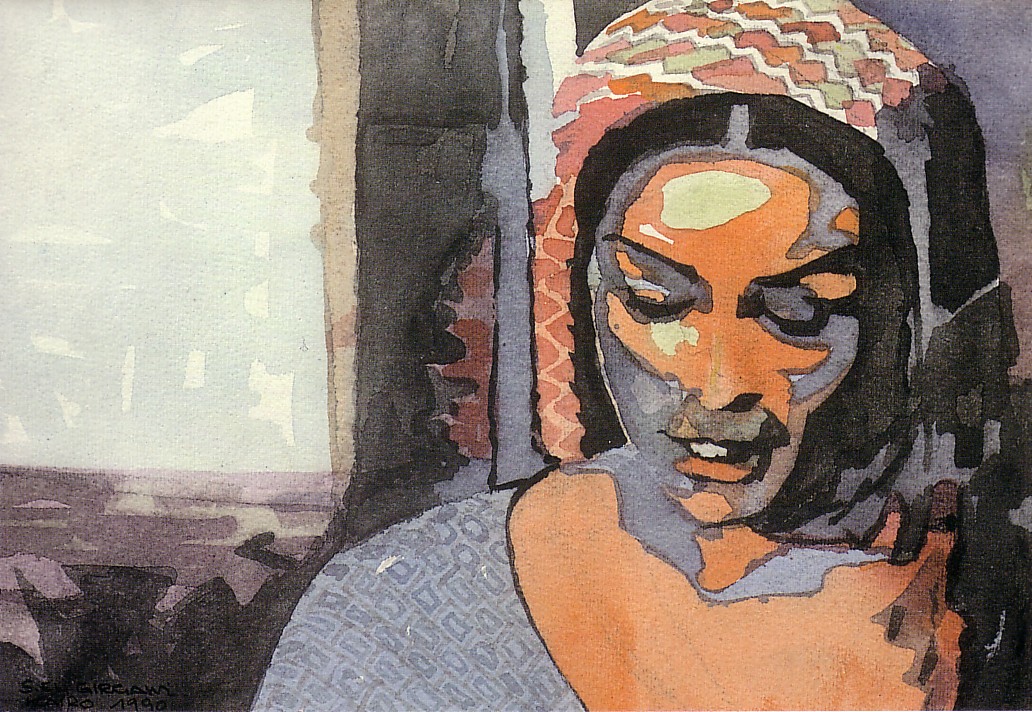| Rosa Gonzales
SAAD EL GIRGAWI - EXPATRIATE PAINTER
Sometimes it is true to say that exiled artists lose the connection to the society that provided the background and ‘humus’ for their art. In other cases, the distance sharpens the perception and increases the longing. The Egyptian expatriate artist Saad el Girgawi seems to belong to the second category. Saad was born in Cairo, of parents hailing from a small location in Upper Egypt, at a time when the country was still a British colony. Finishing high school a year after the war, in 1946, he studied art at the Faculty of Fine Arts in Cairo till 1951 and worked as an art teacher in Cairo and Alexandria, as well as Komombo and Assuan (both in Upper Egypt) during much of that decade. These were perhaps the most important formative years of his career, especially when he was in the last two locations and came to know the social reality of places far away from the capital. As Faisal Ashour mentioned, it was during this stay in Upper Egypt that Saad discovered for himself ancient Egyptian art.* During those years he took part in exhibitions in Cairo, Alexandria, Peking, New Delhi and several South American capitals. Then, following an offer to become art director of a Kuwaiti monthly, he became an expatriate artist, spending the next three years in that small, oil-rich country. In 1964, he emigrated to Germany where he joined the Munich Kunstverein as a member in 1966 and has been an art teacher in Nuremberg since 1973. Time and again, he visited his native Egypt, a fact that has not been without consequences for his further work as an artist. He had important exhibitions in Munich as well as Yugoslavia, and is presently the honored guest artist of the 9th Cairo International Biennale. This honor accorded by the Egyptian Ministry of Culture is truly deserved, despite his long absence from Egypt. As anybody familiar with his oeuvre will confirm, Saad’s importance as an artist depends to a large degree on the fact that he is still referring, in quite a few of his works, to the culture that influenced him so much during his earlier years. It was by confronting the Egyptian landscape as well as the social reality of Upper Egyptian small towns and modest villages that he was able to organically absorb and “Africanize” an academic training originally focused on Western paradigms. It was here, immersed in the North African Arab socio-cultural reality of Upper Egypt, that the composition and coloration of his works began to respond to specific requirements, prescribed by what he saw and how he was able to see it, in a country with a pictorial tradition reaching back more than 5,000 years. Saad’s work, as that of so many Arab painters, is not
thinkable without a cultural exchange with the West. But even more so,
his own heritage has been rediscovered and developed by him, in a way that
makes him all but “a Western artist from Egypt.”
Saad el Girgawi, "Bent el Balad" (water-color, 30 x 40 cm)
We are indebted to him, for the courage that kept him
searching for his own distinct ways of expression, rooted in a cultural
experience that is inseparably connected with Egyptian social reality.
In this, he is a living proof that non-Western modern art is possible and
that we can escape the trend of cultural ‘globalization’ that would
allow only a homogenous, Westernized mode of contemporary artistic expression.
* See Faisal Aschour, "Der Personenmaler Saad el Girgawi", in: R. Boutros et al., Saad El Girgawi, Maler und Bildhauer, Nürnberg 1989 |
